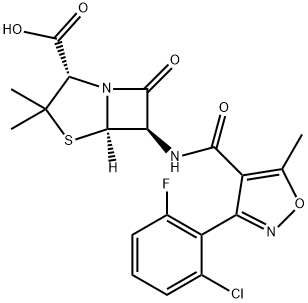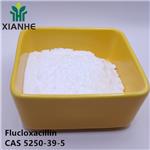Chemically this is 3(2-chloro-6-fluorophenyl)-5-methyl-4-isoxazolyl
penicillin; this differs from dicloxacillin only by the substitution of a fluorine for a chlorine atom (Sutherland et al., 1970). It comes as oral
capsules of 250 and 500 mg, as a suspension of 25 and 50 mg/ml, and in
an injectable formulation of 500 mg and 1 g.
ChEBI: A penicillin compound having a 6beta-[3-(2-chloro-6-fluorophenyl)-5-methyl-1,2-oxazole-4-carboxamido] side-chain.
3-(2-chloro-6-fluorophenyl)-5-methylisoxazole-4-carboxylicacid, MP 206° to
207°C, was obtained by chlorinating 2-chloro-6-fluorobenzaldoxime, then
condensing the resulting hydroxamoyl chloride with methyl acetoacetate in
methanolic sodium methoxide and hydrolyzing the resulting ester with hot
alkali. The acid chloride resulted from treatment of the acid with thionyl
chloride
A suspension of 6-aminopenicillanic acid (36.4 grams) in water was adjusted
to pH 7.2 by the addition of N aqueous sodium hydroxide and the resulting
solution was treated with a solution of 3-(2-chloro-6-fluorophenyl)-5-
methylisoxazole-4-carbonyl chloride (46.1 grams) in isobutyl methyl ketone.
The mixture was stirred vigorously for 1? hours and then filtered through Dicalite. The layers were separated and the isobutyl methyl ketone layer was
shaken with saturated brine. Then, precipitation of the sodium salt only took
place after dilution of the mixture with ether. In this way there was obtained
60.7 grams of the penicillin sodium salt having a purity of 88% as determined
by alkalimetric assay.
There is complete cross-resistance with other
penicillinase-stable penicillins.
Flucloxacillin was synthesized by Beecham Research Laboratories in 1962 as a penicillinase-stable and orally active semisynthetic penicillin. It shows almost the same activity as dicloxacillin, and it has slightly higher serum and tissue concentrations than dicloxacillin. This drug has been used to treat pyoderma, sepsis, and postoperative infections as well as ear and nose, respiratory tract, and other infections caused by Staphylococcus and Streptococcus, including benzylpenicillin-resistant strains.
Oral absorption: c. 80%
Cmax 250 mg (oral): 11 mg/L after 0.5–1 h
Plasma half-life: 2 h
Plasma protein binding: 95%
Absorption and distribution
It is well absorbed after oral administration and penetrates rapidly into extravascular exudates. Its high protein binding limits its diffusion, notably into the normal CSF.
Metabolism and excretion
Flucloxacillin is partly metabolized in the liver and about 10% of the plasma concentration is made up of metabolites. It is more slowly eliminated than cloxacillin. Some appears in the bile but about 50–80% of an oral dose is recovered from the urine, about 20% as metabolites.
Uses are those of group 3 penicillins.
In patients treated by intravenous infusion, about 5% developed
phlebitis by the first and 15% by the second day, after
which the proportion rose dramatically. Side effects are otherwise
those common to penicillins.
Potentially hazardous interactions with other drugs
Reduces excretion of methotrexate.
In normal subjects approximately 10% of the flucloxacillin
administered is metabolised to penicilloic acid. Excretion
occurs mainly through the kidney. Between 65.5%
(oral route) and 76.1% (parenteral route) of the dose
administered is recovered in unaltered active form in
the urine within 8 hours. A small portion of the dose
administered is excreted in the bile.


